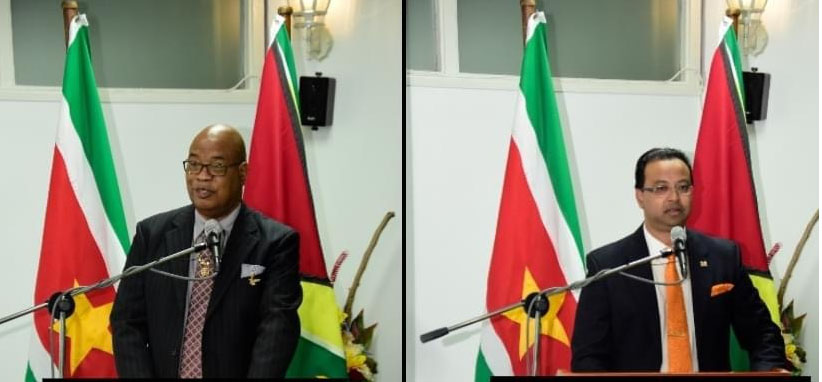A meeting between the governments of Guyana and Suriname will be held soon to discuss the way forward regarding the financing of the proposed Corentyne River Bridge, Minister of Public Works Juan Edghill says.
The planned meeting comes following word from the two companies that qualified for the project that they are unable to meet the pre-financing terms set out.
“We are awaiting a meeting with Suriname and will not comment before the engagement, since this is a joint project,” Minister of Public Works Juan Edghill told the Sunday Stabroek on Friday when contacted.

Suriname newspaper, De Ware Tijd (DWT), reported that on January 8, Surinamese President Chandrikapersad ‘Chan’ Santokhi, stated that the qualified companies have disclosed that the Public-Private Partnership (PPP) model proposed was not feasible, and both countries are now to look at financing.
According to DWT, Santokhi said that after the advice of the two ministers of public works, the two heads of government will decide on how to proceed with the project.
In mid-October of last year, Edghill had announced that two companies, Dutch engineering company, Ballast Nedam and Chinese-owned China Road and Bridge Corporation (CRBC) had submitted proposals to build the bridge over the Corentyne River to link Guyana and Suriname.
Following an evaluation of the submissions, a proposal was to be made to Georgetown and Paramaribo and upon agreement, the selected company was to be announced, this newspaper was told.
However, no one from the Guyana Government has said anything to date on the pronouncements by the two firms that they are unable to finance the project and it was only after the Surinamese Presi-dent’s announcement and the media in Suriname reported it that Guyanese became aware.
Five companies had been pre-qualified as contractors/joint ventures. They were CRBC; China Railway Construction Inter-national Ltd, China Railway Construction Caribbean Co Ltd and China Railway Construction Bridge Engineering Bureau Group Co Ltd; Ballast Nedam Infra Suriname B.V; China Harbour Engineer-ing Company; and China Overseas Engi-neering Group Co Ltd, China Railway Eryuan Engineering Group Co Ltd and China Railway First Group.
With only two companies having submitted bids, it is unclear what the reason was for the diminished interest from the other three companies.
DWT reported Suriname’s Minister of Public Works Dr Riad Nurmohamed saying that the PPP model price tag presented by one company amounted to “four times as high” as what was expected.
“According to the minister, there is no reason to (issue) a new tender. The two governments will be advised to engage with the lowest bidder and seek ‘cheap funding,’” DWT said.
When the project was announced, the Ministry of Public Works had said that that the Corentyne River Bridge would be constructed as a PPP arrangement in accordance with the Design-Build-Finance-Operate-Maintain model (DBFOM). This means that the successful contractor or joint venture would have been responsible for its final design, construction, financing, operation.
Trinidad-based consultants, WSP Caribbean, designed and proposed a two-section bridge connected by an island in the Corentyne River to link Guyana and Suriname. The design of the bridge was unveiled in June during a high-level decision makers meeting (HLDM) when the consulting team made a detailed presentation on the feasibility and design of the new infrastructure.
At the time, Edghill had hosted Dr Nurmohanmed and a technical team from WSP Caribbean.
The HLDM, a release from the public works ministry had explained, was a milestone activity of the consultancy where the key experts from WSP Caribbean present the main findings and key considerations and field questions from the Guyana and Suriname teams. The first HLDM was held in Suriname from February 27 to 28.
Edghill had stated that both sides were hoping to have a contract in place by October of last year. He also explained that both countries will independently evaluate the bids and then meet, discuss, and share their thoughts before selecting the most competitive bidder. Once both sides agree on the most suitable bidder, they will proceed to engage the contractor.
For his part, Suriname’s Dr Nurmohamed had stated that he was happy with the progress made, “Building the bridge is very high on the agenda for both countries… from our side, we will continue our work based on what studies have said.”
The cost of the bridge along with other reports on the traffic projections/forecasts, financial and economic evaluation, environmental assessment, legal framework, and the design of the roads, among other technical aspects, were then still to be finalised.
WSP in explaining their design said the bridge will feature two lanes and will be able to accommodate a third in cases of emergencies or controlled conditions. The bridge superstructure will have a total deck width of 12.4 metres including lanes and shoulders with the carriageway measuring 10.05 metres. It will also have utilities inside the box girder with an internal inspection path width, an on-top inspection path; wearing surface: extra concrete thickness, milled after closure. The bridge will also feature steel railing along with solar-powered luminaires at the deck slab edge, next to the deck inspection path.
From Guyana’s end, the bridge will be 1,100 metres with 22 spans, each measuring 50 metres in length while at Suri-name’s end it will feature an elevated section.
That section of the bridge will comprise two zones. Zone ‘A’ East it was explained, will consist of 20 spans at 1,000 metres and Zone ‘A’ West with 19 spans at 950 metres. The WSP representative indicated that Zone ‘B’ which is referred to as the Main Bridge, will consist of 80 to 130-metre spans. Further, all the main bridge’s piers will be protected against ship impact and piers, and the access bridges will be protected by guiding monopile dolphins connected through tethered floating fenders.
Guyana and Suriname signed a memorandum for the bridge on November 24, 2020 during a visit by President Irfaan Ali to Paramaribo.





